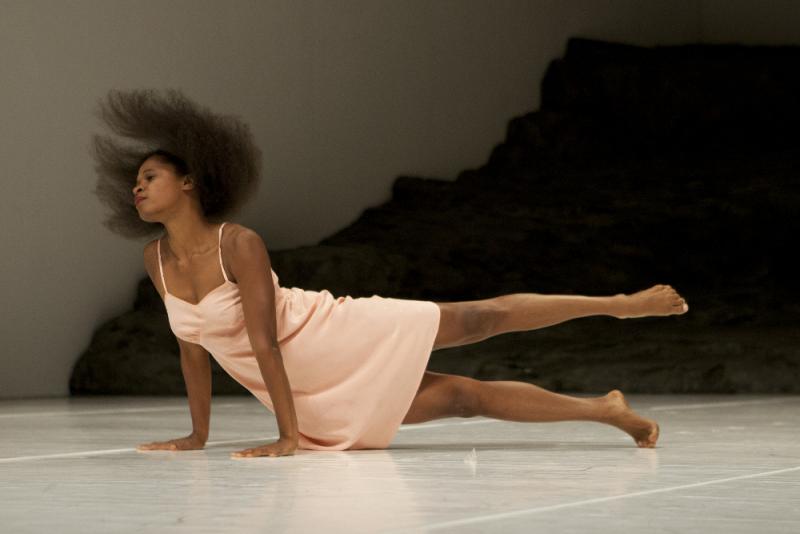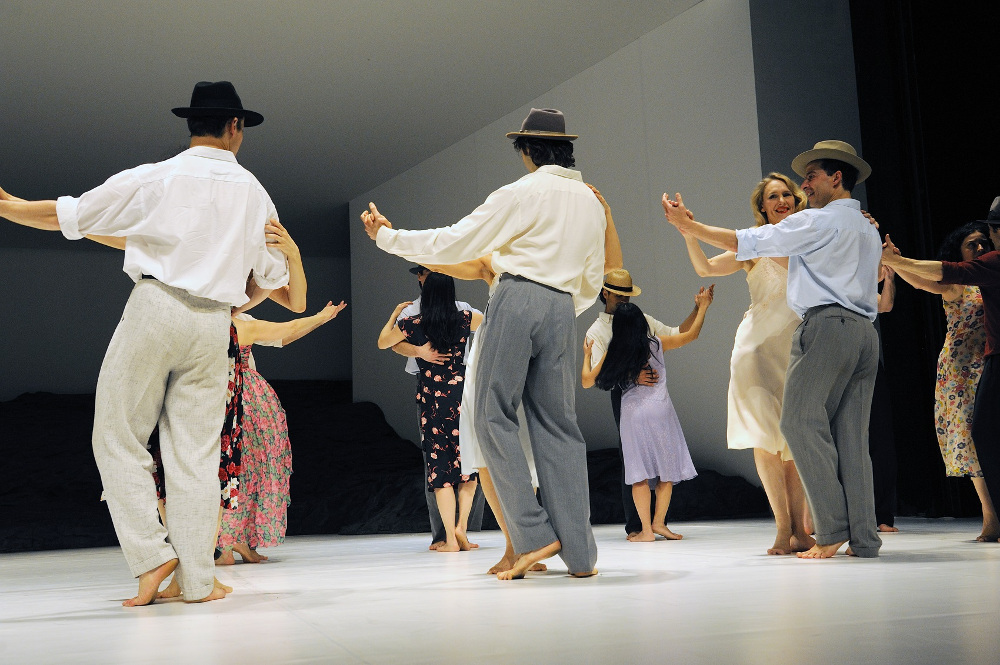Masurca Fogo, Pina Bausch, Sadler's Wells | reviews, news & interviews
Masurca Fogo, Pina Bausch, Sadler's Wells
Masurca Fogo, Pina Bausch, Sadler's Wells
Tanztheater Wuppertal in one of their founder's lightweight works

Tanztheater Wuppertal Pina Bausch are at an interesting juncture. Eight years after their eponymous founder died, and over 40 since she took over at Wuppertal, the troupe is reaching a point when, even if Bausch were alive, it would be facing change, as the older dancers in the company - many of whom have been there since the beginning - enter their late 60s.
Bausch, of course, was not in the slightest bit reluctant to put older dancers on stage - one of the most wonderful and distinctive things about her choreography is the sheer variety of ages, body shapes, nationalities on display - and she would have hired new dancers, borne the loss of familiar faces, and mounted her back catalogue with the same ingenuity and assurance she displayed throughout her career. But so strong and distinctive was her genius that it seems - if possible - harder than ever that her company should now have to do all these things without her.
It may seem odd that Masurca Fogo provoked such melancholy reflections, since the Portugal-inspired, 1998 piece is among the sunniest in Bausch's oeuvre. Compared to the likes of Auf dem Gebirge..., which the Wuppertalers brought to Sadler's Wells two years ago, Masurca Fogo is a beach holiday. The kind of searing sequences that make some of her pieces so uncomfortable to watch - like a man blowing up balloons till they burst in his face or a woman running and running and always being knocked over by some men holding a table - are absent. Masurca Fogo wears its sharpness much more gently: it highlights absurdity and the oddness of relationships, as all Bausch's work does, but with an attitude more akin to the raised eyebrow of a sceptical grandmother, rather than the anguished testimony of the oppressed. Witness the scene when an older dancer (Nazareth Panadero) tells us how beautiful she is, and all the men follow her around sighing 'ah', completely ignoring half a dozen younger, more nubile dancers in swimsuits at the back of the stage. Are we to think that she, like many of Bausch's characters, has a loose grasp on reality? Or is it actually a spirited defence of the confident sexuality of older women? It says both, perhaps, but it says them gently.
In some sequences, the lightheartedness is simply delightful: no-one will forget in a hurry the end of the first half, which sees four dancers in swimming costumes cavort, giggling, in an improvised water slide while a rubber walrus lumbers across the stage behind them and Regina Advento smiles seductively from a bubble bath out of which she occasionally pulls a clean plate and hands it to Andrey Berezin to dry. Orgasm jokes are funny; a brief dance party in a makeshift beach shack is uplifting; and there is the usual Bausch play with both drinking and eating – dancers blow water jets, dump sugar over coffee, and generally feed and splash themselves and others in a variety of creative ways.

All this is good. But there are longueurs too, often coinciding with video projections. These, with the exception of a some euphorically surging waves near the end, are generally distracting and in some cases just boring; a series of flowers opening while dancers lay prone on the floor was one of the most yawn-worthy sequences I've seen in a Bausch work. There are a fair number of straight dance sequences, which I generally find less exciting than the tanztheater antics; yes, we got to see lots of the new young male dancers strutting their stuff, but actually, the glory of Tanztheater Wuppertal is difficult to separate from its veteran members and the young chaps' dancing left no after-image on the retina to compare with Andrey Berezin pushing dancing couples around while wearing a burgundy taffeta dress, unseen heels, and a rigid poker face: dowager duchess, dancing master, and Lurch the butler rolled into one, glorious, package.
Those who saw Masurca Fogo on its last London outing 15 years ago will be more able than I to say whether the muted tone of last night's performance is attributable more to the piece or to the position the company finds itself in these days. I love Tanztheater Wuppertal; I love Bausch's work. It would be wonderful if they were both immortal and infallible, but they are not; Masurca Fogo shows neither at their best. But Bausch on a bad day is still better than many choreographers on a good one. Her company and her work are always worth seeing, and we are lucky indeed that they visit London so frequently.
- Tanztheater Wuppertal Pina Bausch perform Masurca Fogo at Sadler's Wells until 12 February
- Read more dance reviews on theartsdesk
rating
Explore topics
Share this article
Add comment
more Dance
 All You Need Is Death review - a future folk horror classic
Irish folkies seek a cursed ancient song in Paul Duane's impressive fiction debut
All You Need Is Death review - a future folk horror classic
Irish folkies seek a cursed ancient song in Paul Duane's impressive fiction debut
 MacMillan Celebrated, Royal Ballet review - out of mothballs, three vintage works to marvel at
Less-known pieces spanning the career of a great choreographer underline his greatness
MacMillan Celebrated, Royal Ballet review - out of mothballs, three vintage works to marvel at
Less-known pieces spanning the career of a great choreographer underline his greatness
 Carmen, English National Ballet review - lots of energy, even violence, but nothing new to say
Johan Inger's take on Carmen tries but fails to make a point about male violence
Carmen, English National Ballet review - lots of energy, even violence, but nothing new to say
Johan Inger's take on Carmen tries but fails to make a point about male violence
 WAKE, National Stadium, Dublin review - a rainbow river of dance, song, and so much else
THISISPOPBABY serves up a joyous tapestry of Ireland contemporary and traditional
WAKE, National Stadium, Dublin review - a rainbow river of dance, song, and so much else
THISISPOPBABY serves up a joyous tapestry of Ireland contemporary and traditional
 Swan Lake, Royal Ballet review - grand, eloquent, superb
Liam Scarlett's fine refashioning returns for a third season, and looks better than ever
Swan Lake, Royal Ballet review - grand, eloquent, superb
Liam Scarlett's fine refashioning returns for a third season, and looks better than ever
 First Person: Ten Years On - Flamenco guitarist Paco Peña pays tribute to his friend, the late, great Paco de Lucía
On the 10th anniversary of his death, memories of the prodigious musician who broadened the reach of flamenco into jazz and beyond
First Person: Ten Years On - Flamenco guitarist Paco Peña pays tribute to his friend, the late, great Paco de Lucía
On the 10th anniversary of his death, memories of the prodigious musician who broadened the reach of flamenco into jazz and beyond
 Dance for Ukraine Gala, London Palladium review - a second rich helping of international dancers
Ivan Putrov's latest gala was a satisfying mix of stars and young hopefuls
Dance for Ukraine Gala, London Palladium review - a second rich helping of international dancers
Ivan Putrov's latest gala was a satisfying mix of stars and young hopefuls
 Nelken: A Piece by Pina Bausch, Sadler's Wells review - welcome return for an indelible classic
A new generation of gifted performers for us to get to know
Nelken: A Piece by Pina Bausch, Sadler's Wells review - welcome return for an indelible classic
A new generation of gifted performers for us to get to know
 Dark With Excessive Bright, Royal Ballet review - a close encounter with dancers stripped bare
The Royal's Festival of New Choreography launches with an unforgettable walk in the dark
Dark With Excessive Bright, Royal Ballet review - a close encounter with dancers stripped bare
The Royal's Festival of New Choreography launches with an unforgettable walk in the dark
 La Strada, Sadler's Wells review - a long and bumpy road
Even the exceptional talents of Alina Cojocaru can't save dance adaptation of Fellini film
La Strada, Sadler's Wells review - a long and bumpy road
Even the exceptional talents of Alina Cojocaru can't save dance adaptation of Fellini film
 First Person: pioneering juggler Sean Gandini reflects on how the spirit of Pina Bausch has infiltrated his work
As Tanztheater Wuppertal Pina Bausch's 'Nelken' comes to Sadler’s Wells, a tribute from across the art forms
First Person: pioneering juggler Sean Gandini reflects on how the spirit of Pina Bausch has infiltrated his work
As Tanztheater Wuppertal Pina Bausch's 'Nelken' comes to Sadler’s Wells, a tribute from across the art forms
 Manon, Royal Ballet review - a glorious half-century revival of a modern classic
Fifty years on, Kenneth MacMillan's crash-and-burn anti-heroine is riding high
Manon, Royal Ballet review - a glorious half-century revival of a modern classic
Fifty years on, Kenneth MacMillan's crash-and-burn anti-heroine is riding high

Comments
I still have my quirky